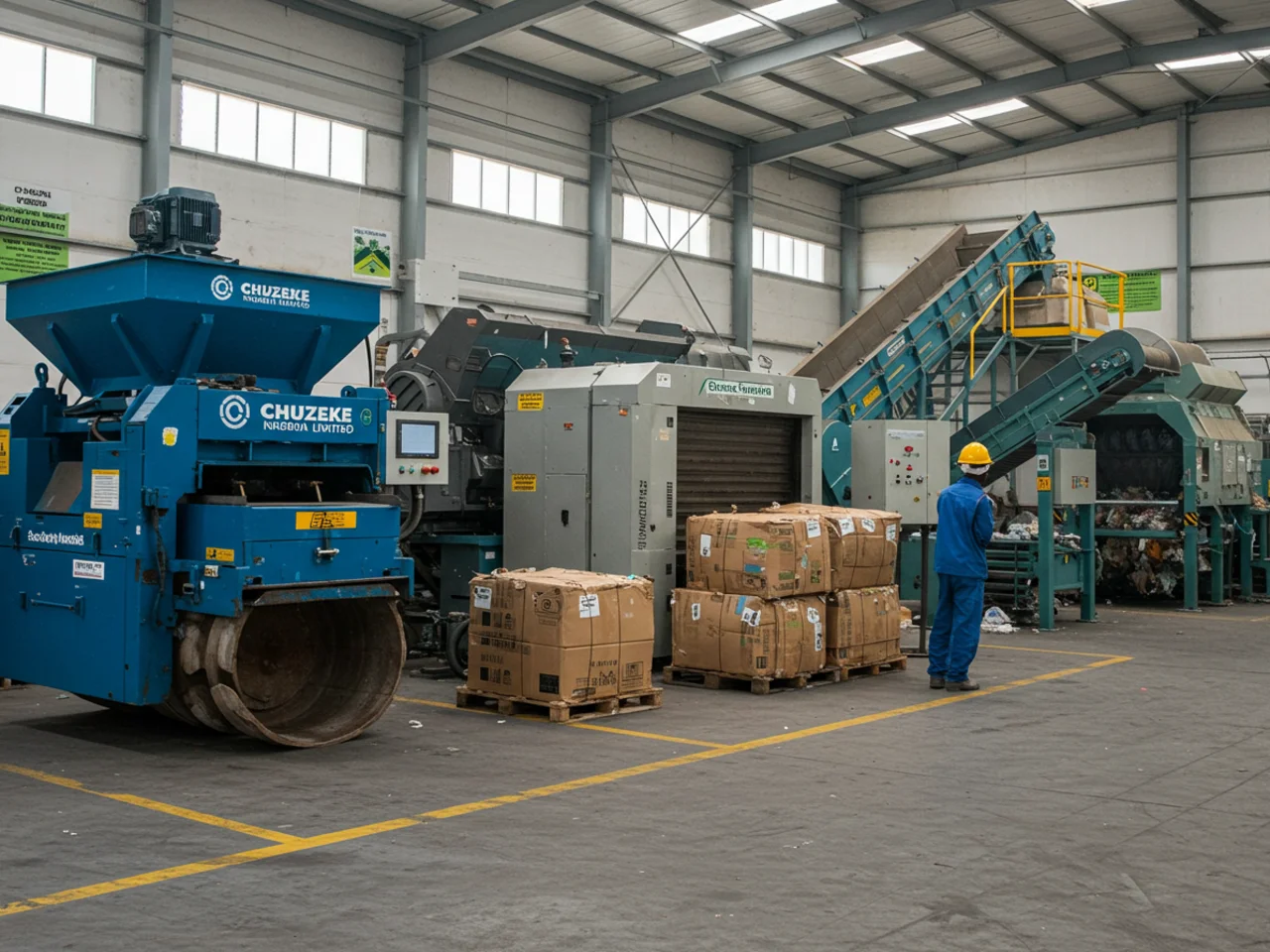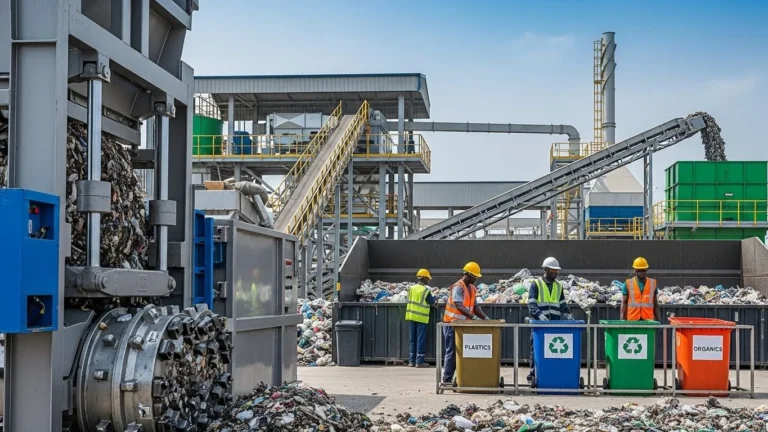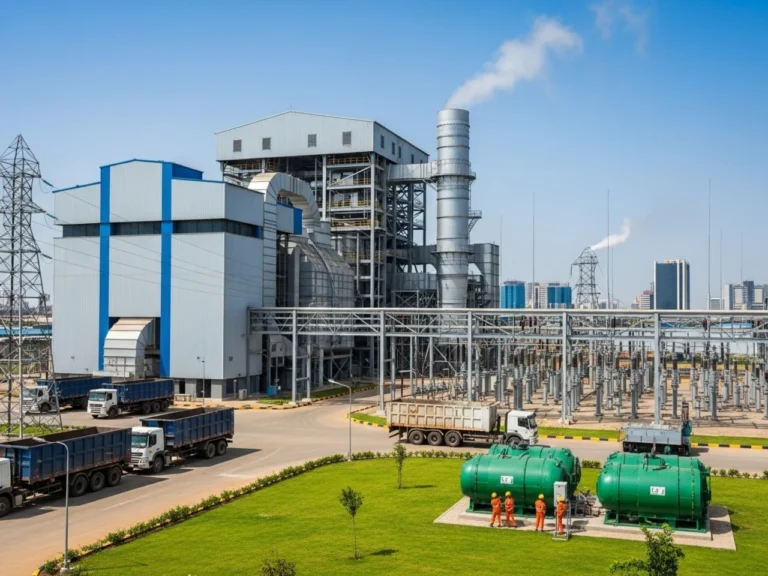Incinerators in Nigeria: Types, Applications & NESREA Compliance
Finding the right incinerator system for your Nigerian operation can feel overwhelming. With NESREA compliance requirements, technology options, and cost considerations, many industrial leaders struggle to make informed decisions regarding waste management.
You’re not alone in this challenge. Whether you’re managing medical waste at a Lagos hospital, handling drilling mud at a Port Harcourt oil field, or processing industrial waste at a Kano manufacturing facility, choosing the wrong incinerator can cause regulatory issues, high costs, and operational problems.
The fact is that, with proper guidance and knowledge of Nigerian regulations, you can select and implement an incinerator system that meets NESREA standards and provides lasting operational and financial benefits for your organization.
Understanding Incinerators: What They Are and How They Work
Think of an incinerator as a highly engineered furnace designed specifically for waste destruction. Unlike simple burning, incineration is a controlled thermal process that safely converts various waste materials into ash, clean gases, and recoverable energy.
The magic happens in three carefully orchestrated stages:
Stage 1: Primary Combustion
Your waste enters the main chamber where it burns at precisely controlled temperatures. This isn’t random burning – the system carefully manages air flow, temperature, and residence time to ensure complete material breakdown.
Stage 2: Secondary Treatment
Any remaining gases pass into a second chamber where they’re heated to even higher temperatures. This step eliminates any remaining organic compounds and ensures the destruction of potentially harmful substances.
Stage 3: Emission Control
Before anything leaves the stack, sophisticated pollution control systems scrub and filter the gases. This is where NESREA compliance happens – removing particulates, acid gases, and other regulated emissions to meet Nigerian environmental standards.
The Right Incinerator for Your Nigerian Industry
Not all incinerators are created equal. The type that works perfectly for a Port Harcourt hospital might be completely wrong for an Abuja construction company. Let’s break down the main categories and where they fit best.
Medical Waste Incinerators: Protecting Public Health
If you’re running a healthcare facility, medical waste incinerators are your frontline defense against infectious disease spread. These specialized systems must meet strict pathogen destruction requirements while handling everything from surgical waste to pharmaceutical residues.
Controlled Air Incinerators: The Nigerian Standard
Walk into most Nigerian hospitals with on-site incineration, and you’ll likely see a controlled air (also called starved-air) system.
Here’s why they’ve become the preferred choice:
- Two-stage destruction process: Waste first pyrolyzes in an oxygen-limited environment at 760-980°C, then gases combust completely at 980-1100°C
- Proven pathogen destruction: Meets WHO guidelines for infectious waste treatment
- Manageable operating costs: Lower fuel consumption compared to excess-air systems
- NESREA compliance: Designed specifically to meet Nigerian medical waste regulations
The capacity range typically runs from 25 kg/hour for small clinics up to 500 kg/hour for major medical centers. Most systems include automated ash removal and integrated pollution control to minimize operator involvement.
Industrial Waste Incinerators: Handling Complex Waste Streams
Manufacturing operations, chemical plants, and research facilities generate waste that can’t safely go to regular landfills. Industrial incinerators step in to handle these challenging materials safely and legally.
Rotary Kiln Systems: The Versatile Workhorses
When your waste stream changes daily – maybe pharmaceutical residues on Monday, contaminated packaging Tuesday, and laboratory chemicals Wednesday – rotary kiln incinerators provide the flexibility you need.
Here’s what makes them special:
- Tumbling action: The rotating cylinder ensures complete mixing and even heating
- Temperature flexibility: Can operate anywhere from 850-1200°C, depending on waste type
- High residence time: Extended heating ensures destruction of complex compounds
- Robust construction: Built to handle abrasive and corrosive materials
For Nigerian operations, typical sizes range from 100-2000 kg/hour capacity. The higher initial cost often pays off through operational flexibility and regulatory compliance confidence.
Oil Field Waste Incinerators: Solutions for Remote Operations
Oil and gas operations present unique challenges. You’re often in remote locations, dealing with hydrocarbon-contaminated materials, and operating under both NESREA and NUPRC oversight. Standard waste management approaches often fall short.
The Mobile Solution Revolution
Smart oil companies have discovered that mobile incinerator units solve multiple problems at once:
- Drilling mud management: Handle oil-based mud waste right at the wellsite
- PPE disposal: Safely destroy contaminated protective equipment daily
- Tank cleaning residues: Process hydrocarbon waste without transport risks
- Rapid deployment: Containerized units can be operational within days of arrival
Capacity typically ranges from 50-500 kg/hour, perfect for most drilling and production operations. The self-contained pollution control means you’re not dependent on local infrastructure that might not exist in remote areas.
Fixed Installation Benefits
For major production facilities and support bases, permanent installations often make more sense:
- Higher capacity: Process waste from multiple operations
- Energy recovery: Use waste heat for facility heating or power generation
- Cost efficiency: Lower per-ton processing costs for high-volume operations
- Multi-stream capability: Handle different waste types in the same system
Where Different Industries Benefit Most
Let’s get practical about which incinerator applications deliver the best results for specific Nigerian industry sectors.
Waste Management Companies: Volume and Versatility
If you’re running a waste management operation, incinerators can transform your business model from simple hauling to comprehensive waste treatment services.
Municipal Solid Waste Processing
Large mass-burn incinerators help you:
- Reduce landfill dependency (critical as Nigerian landfills reach capacity)
- Generate revenue through energy recovery
- Meet growing demand for waste-to-energy solutions
- Position for future carbon credit opportunities
Hazardous Waste Services
Specialized systems let you offer premium services:
- Medical waste treatment for healthcare networks
- Industrial waste processing for manufacturers
- Pharmaceutical destruction for expired medications
- Chemical waste treatment for research institutions
The key is matching system capacity to your service area. A facility serving Lagos might need a different capacity than one serving Port Harcourt or Abuja.
Oil and Gas Companies: Regulatory Compliance Made Simple
The petroleum industry faces some of Nigeria’s strictest environmental oversight. Between NUPRC requirements and NESREA standards, compliance can feel like navigating a regulatory minefield.
Offshore Operations
Platform-based incinerators solve multiple challenges:
- Space constraints: Compact shipboard units fit existing deck layouts
- Zero discharge requirements: Complete on-board waste destruction
- International waters compliance: Meet both Nigerian and international maritime standards
- Crew safety: Eliminate contaminated waste storage risks
Onshore Facilities
Production facilities and drilling sites benefit from:
- Immediate waste processing: No storage or transport delays
- Cost predictability: Eliminate third-party disposal fees and transport costs
- Security control: Keep sensitive operational waste on-site
- Emergency response capability: Handle spill cleanup materials immediately
Engineering and Construction: Project-Specific Solutions
Construction projects generate diverse waste streams that change as work progresses. The concrete phase produces different waste than electrical or finishing work.
Temporary Installation Strategy
Mobile units work well for:
- Large construction projects: Multi-year developments with changing waste streams
- Remote construction: Sites where waste transport is expensive or impractical
- Contaminated site remediation: Immediate treatment of contaminated materials
- Emergency response: Rapid deployment for environmental cleanup projects
Permanent Facility Approach
For construction companies with multiple ongoing projects:
- Central processing: Bring waste from multiple sites to one facility
- Economies of scale: Lower per-ton processing costs
- Service revenue: Process waste for other construction companies
- Long-term planning: Investment pays off over multiple projects
Steel Production: Integration Opportunities
Steel plants generate substantial waste heat and have existing high-temperature processes. This creates unique opportunities for incinerator integration.
Waste Heat Recovery
Smart integration can:
- Reduce fuel costs: Use incinerator heat for steel production processes
- Improve efficiency: Integrate waste processing into existing material flows
- Lower emissions: Combine emission control systems for cost savings
- Generate steam: Use waste heat for power generation or process steam
NESREA Compliance: Your Roadmap to Legal Operation
Let’s be direct: Operating an incinerator in Nigeria without proper NESREA compliance isn’t just risky – it’s a path to significant financial and legal problems. The good news is that compliance is straightforward when you understand the requirements.
Getting Your Permits: The Essential First Steps
Environmental Impact Assessment (EIA): Your Foundation Document
Before you install any incinerator system, NESREA requires a comprehensive EIA. Think of this as your environmental roadmap that demonstrates you’ve considered and planned for all environmental impacts.
The EIA process involves:
- Site assessment: Detailed evaluation of your proposed location
- Air quality modeling: Computer simulations showing emission impacts
- Public consultation: Community meetings and stakeholder input (required for larger facilities)
- Mitigation planning: Specific measures to minimize environmental impact
Most EIAs take 3-6 months to complete and approve. Starting early prevents project delays.
Operating Permits: Your License to Operate
Once your EIA is approved and your incinerator is installed, you need an annual operating permit. This isn’t just paperwork – it’s NESREA’s way of ensuring ongoing compliance.
Your permit will specify:
- Waste acceptance limits: What types and quantities you can process
- Operating restrictions: Temperature ranges, throughput limits, operating hours
- Monitoring requirements: What you must measure and how often
- Reporting schedules: When and what data you must submit
Emission Standards: The Numbers That Matter
NESREA doesn’t guess about air quality – they set specific, measurable limits that your incinerator must meet continuously.
Key Pollutant Limits
(measured at 11% oxygen, dry basis):
- Particulate matter: 30 mg/m³ (Think of this as the “smoke” standard)
- Carbon monoxide: 100 mg/m³ (Indicates complete combustion)
- Organic compounds: 20 mg/m³ (Covers partially burned materials)
- Hydrogen chloride: 60 mg/m³ (From plastic and PVC waste)
- Sulfur dioxide: 300 mg/m³ (From sulfur-containing materials)
Heavy Metal Controls
These are particularly important for medical and industrial waste:
- Mercury: 0.1 mg/m³ (Critical for medical waste with mercury-containing items)
- Cadmium + Thallium: 0.1 mg/m³ (Combined limit for these toxic metals)
- Other heavy metals: 1.0 mg/m³ (Lead, chromium, copper, manganese combined)
Dioxin and Furan Limits
The most stringent requirements:
- New facilities: 0.5 ng TEQ/m³
- Existing facilities: 1.0 ng TEQ/m³
- These ultra-low limits require sophisticated pollution control and careful operation.
Monitoring: Proving Compliance Every Day
NESREA doesn’t just trust that you’re meeting standards; they require continuous proof of compliance.
Continuous Monitoring Systems
Your incinerator must automatically measure and record:
- Combustion temperatures: Ensuring complete waste destruction
- Oxygen levels: Confirming proper combustion air supply
- Carbon monoxide: Real-time combustion efficiency indicator
- Particulate emissions: Continuous dust monitoring
Periodic Testing Requirements
Some parameters need professional testing:
- Annual stack tests: Complete analysis of all regulated pollutants
- Quarterly dioxin sampling: Specialized testing for ultra-trace compounds
- Semi-annual metals analysis: Heavy metal emission verification
- Monthly opacity readings: Visual emission assessments
Choosing the Right Incinerator: A Practical Selection Guide
Here’s where many Nigerian companies make expensive mistakes. They either oversize their system (wasting money) or undersize it (creating operational headaches). Let’s walk through the selection process step by step.
Step 1: Know Your Waste (Better Than You Think You Do)
Most companies underestimate the importance of detailed waste characterization. You need specific data, not rough estimates
Waste Generation Assessment
Start with actual measurements:
- Daily generation rates: Weigh and record waste by type for at least 30 days
- Composition analysis: What percentage is paper, plastic, organic matter, metals?
- Heating value: How much energy is in your waste? (Critical for sizing)
- Moisture content: Wet waste needs more energy to burn completely
- Seasonal variations: Many operations see 20-50% variation between peak and low periods
Pro tip: Include a 20% safety factor in your calculations. It’s much cheaper to oversize slightly than to discover your system can’t handle peak loads.
Step 2: Match Technology to Your Reality
Small Operations (Under 100 kg/hour) Perfect for:
- Small medical clinics
- Research laboratories
- Small manufacturing facilities
- Remote construction sites
Best technology choices:
- Controlled air systems for medical waste
- Batch-fed units for irregular waste streams
- Simple pollution control (cyclones and basic scrubbers)
- Manual or semi-automatic operation
Medium Operations (100-500 kg/hour)
Ideal for:
- Regional hospitals
- Mid-size manufacturing plants
- Oil field support bases
- Multi-site waste management companies
Technology recommendations:
- Continuous feed systems for consistent operation
- Advanced pollution control systems for NESREA compliance
- Heat recovery systems for energy cost reduction
- Professional operation and maintenance support
Large Operations (Over 500 kg/hour) Required for:
- Major medical centers
- Large industrial complexes
- Municipal waste management facilities
- Multi-client commercial operations
System requirements:
- Rotary kiln or advanced controlled air technology
- Sophisticated emission control with continuous monitoring
- Energy recovery systems (economic necessity at this scale)
- Full-time certified operators and maintenance staff
Installation and Commissioning: Getting It Right the First Time
Most incinerator problems trace back to installation mistakes. Poor site preparation, inadequate utilities, or rushed commissioning create years of operational headaches. Here’s how to avoid these expensive mistakes.
Site Preparation: The Foundation of Success
Foundation Requirements That Actually Matter
Your incinerator foundation isn’t just a concrete pad – it’s a precision-engineered structure that affects system performance for decades.
Critical specifications:
- Load calculations: Account for equipment weight plus dynamic loads from operation
- Vibration isolation: Prevent operational vibration from affecting building structures
- Thermal expansion: Allow for metal expansion without stressing connections
- Access planning: Ensure maintenance equipment can reach all components
- Drainage systems: Handle process water, cleaning runoff, and emergencies
Utility Infrastructure Planning
Nothing stops an installation faster than discovering your electrical service is inadequate or your water pressure is too low.
Electrical requirements:
- 415V three-phase power with adequate capacity for full-load operation plus auxiliary systems
- Emergency power considerations for critical safety systems
- Proper grounding for sensitive electronic controls
- Lightning protection for exposed equipment
Process utilities:
- Natural gas or diesel fuel supply with backup capability
- Process water: 2-5 m³/hour for pollution control systems
- Compressed air: 7 bar minimum for pneumatic controls and cleaning systems
- Cooling water for equipment protection (if required)
Commissioning: The Make-or-Break Phase
Professional commissioning prevents 80% of first-year operational problems. Don’t skimp here.
Pre-operational Testing Sequence
Systems integration testing:
- Verify all control systems communicate properly
- Test all safety interlocks and emergency shutdown systems
- Calibrate emission monitoring equipment against reference standards
- Confirm proper operation of all auxiliary equipment
Performance verification:
- Design capacity confirmation with actual waste
- Emission compliance demonstration under full-load conditions
- Thermal efficiency measurement and optimization
- Pollution control system effectiveness verification
Operator Training: Your Long-term Success Insurance
The best incinerator in the world fails with poor operators. Invest in comprehensive training.
Training curriculum essentials:
- Combustion fundamentals: Understanding why the system works the way it does
- NESREA regulations: Current requirements and compliance demonstration
- Safety procedures: Emergency response and normal safety protocols
- Maintenance techniques: Preventive care and basic troubleshooting
- Record keeping: Documentation requirements and regulatory reporting
Maintenance and Operations Best Practices
Preventive Maintenance Program
Daily operations checklist:
- Visual inspection of all systems
- Temperature and pressure readings
- Emission monitoring data review
- Ash removal and disposal
- Fuel consumption recording
Weekly maintenance tasks:
- Refractory inspection and repair
- Pollution control system cleaning
- Calibration of monitoring instruments
- Waste characterization verification
- Equipment lubrication
Monthly major maintenance:
- Complete system inspection
- Refractory replacement as needed
- Pollution control media replacement
- Stack testing preparation
- Regulatory reporting compilation
Operator Training Requirements
Certification levels:
- Level 1: Basic operation and maintenance
- Level 2: Advanced troubleshooting and optimization
- Level 3: System design and regulatory compliance
Training curriculum:
- Combustion theory and practice
- Environmental regulations and compliance
- Safety procedures and emergency response
- Maintenance techniques and scheduling
- Record keeping and reporting
Troubleshooting Common Issues
Combustion Problems
Incomplete combustion symptoms:
- High carbon monoxide emissions
- Visible smoke from stack
- High organic compound levels
- Excessive ash carbon content
Solutions:
- Increase combustion air supply
- Raise the combustion chamber temperature
- Improve waste mixing and feed rate
- Clean air distribution system
Emission Control Issues
High particulate emissions:
- Check the baghouse differential pressure
- Replace damaged filter bags
- Verify pulse cleaning operation
- Adjust the gas conditioning system
Acid gas breakthrough:
- Increase scrubber liquid pH
- Check spray nozzle operation
- Verify reagent feed rate
- Replace packing material
Environmental Impact and Sustainability
Air Quality Benefits
Properly operated incinerators provide environmental benefits:
- Eliminates pathogenic organisms in medical waste
- Reduces waste volume by 85-95%
- Destroys toxic organic compounds
- Recovers energy from waste materials
Emission reductions vs. alternatives:
- Lower greenhouse gas emissions than landfilling
- Eliminates groundwater contamination risk
- Reduces transportation-related emissions
- Recovers materials for beneficial use (metals, energy)
Energy Recovery Opportunities
Heat recovery applications:
- Steam generation for industrial processes
- Hot water for facility heating
- Electricity generation through steam turbines
- Drying of other waste materials
Economic benefits:
- Reduced fuel costs for other operations
- Potential revenue from electricity sales
- Lower waste disposal fees
- Improved corporate sustainability metrics
Regulatory Updates and Future Trends
Recent NESREA Developments
NESREA continues updating environmental standards:
- Stricter emission limits for new facilities
- Enhanced monitoring requirements
- Increased penalties for non-compliance
- Digital reporting systems implementation
Upcoming changes (2024-2025):
- Mandatory continuous emission monitoring for larger units
- Revised waste acceptance criteria
- Enhanced operator certification requirements
- Public access to emission data
Technology Advances
Emerging technologies:
- Plasma gasification for hazardous waste
- Advanced emission control systems
- Automated waste feeding and ash handling
- Remote monitoring and diagnostics
Industry trends:
- Integration with waste-to-energy projects
- Mobile and modular system designs
- Enhanced energy recovery efficiency
- Artificial intelligence for optimization
Cost-Benefit Analysis for Nigerian Industries
Financial Justification
Cost savings opportunities:
- Reduced waste disposal fees: ₦50,000-200,000 per ton
- Lower transportation costs for remote operations
- Energy recovery value: ₦15,000-40,000 per MWh
- Regulatory compliance cost avoidance
Payback period calculations:
- Small medical systems: 3-5 years
- Industrial applications: 5-8 years
- Large commercial operations: 7-12 years
- Enhanced payback with energy recovery: 2-4 years reduction
Risk Mitigation Benefits
Operational risk reduction:
- Eliminates long-term disposal liability
- Reduces dependency on external waste contractors
- Ensures regulatory compliance control
- Provides operational flexibility
Environmental liability protection:
- Complete waste destruction documentation
- Eliminates groundwater contamination risk
- Reduces long-term environmental monitoring
- Meets insurance and bonding requirements
Vendor Selection and Procurement
Key Vendor Evaluation Criteria
Technical capabilities:
- Proven track record in Nigeria
- NESREA-compliant system designs
- Local service and support capabilities
- Spare parts availability and pricing
Financial stability:
- Established Nigerian presence
- Project financing capabilities
- Performance warranty terms
- Long-term service agreements
Request for Proposal Elements
Technical specifications:
- Detailed waste characterization data
- Capacity and availability requirements
- Emission limit compliance
- Site-specific installation requirements
Commercial terms:
- Fixed-price turnkey delivery
- Performance guarantees
- Training and commissioning
- Ongoing service and support
Your Trusted Partner for Incinerator Solutions
Selecting and implementing an incinerator system represents a significant investment in your organization’s future. The decisions you make today about technology, vendor, and approach will impact your operations for decades.
At Chuzeke Nigeria Limited, we understand the complexities of Nigerian industrial operations and NESREA requirements. Our team has guided dozens of companies through successful incinerator implementations, from small medical facilities to large industrial complexes.
Why companies choose our guidance:
- Local expertise: Deep understanding of Nigerian regulatory requirements and operating conditions
- Technical competence: Engineering team with extensive incineration experience
- Vendor neutrality: We help you select the best system for your needs, not just what we sell
- Long-term support: Ongoing assistance with operations, maintenance, and compliance
Ready to explore your options?
Contact our technical team today for a confidential consultation about your specific waste management challenges. We’ll help you understand your options, evaluate alternatives, and develop a practical implementation plan that meets your operational and financial objectives.
Whether you’re dealing with medical waste in Lagos, industrial waste in Kano, or oil field waste in Port Harcourt, we have the expertise to guide you to the right solution.
Don’t let waste management challenges limit your operations. Take control with a properly selected and implemented incinerator system.
Partner with Nigeria's Leading Metal Fabrication services company
Stop dealing with equipment failures and project delays. Get reliable waste management and oil field equipment engineered for Nigerian industrial conditions. We’re ready to build.





